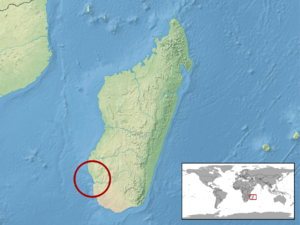Belalanda chameleon facts for kids
Quick facts for kids Belalanda chameleon |
|
|---|---|
| Conservation status | |
| Scientific classification | |
| Genus: |
Furcifer
|
| Species: |
belalandaensis
|
 |
|
The Furcifer belalandaensis, also known as the Belalanda chameleon, is a special kind of chameleon that lives only in Madagascar. It was first found and described by scientists Édouard-Raoul Brygoo and Charles Domergue in 1970. Sadly, this chameleon is in big trouble. The International Union for Conservation of Nature (IUCN) says it is Critically Endangered, which means it's very close to disappearing forever. Groups like the World Wide Fund for Nature (WWF) are working hard to help save it.
Where the Belalanda Chameleon Lives
The Belalanda chameleon lives only in a small area around a town called Belalanda in southwestern Madagascar. This area is very important because it's home to only five types of Critically Endangered reptiles, including this chameleon.
This chameleon has a tiny home range, covering only about 4 square kilometers (about 1.5 square miles). Its original home was in "gallery forests," which are forests found along rivers. But almost all of these forests have been cut down. Now, the chameleon lives in the tops of trees that people have planted, and in the few old native trees that are left.
The biggest danger to these chameleons is logging. People cut down trees to make charcoal, which is used for cooking and heating. This destroys the chameleon's home. These chameleons can be found living at heights of about 18 to 20 meters (about 59 to 66 feet) above sea level.
Even though we don't know exactly how many Belalanda chameleons are left, the IUCN believes their numbers are going down. Good news is that local leaders in Belalanda have banned collecting or selling these chameleons. Local people are also helping to protect them.
What the Belalanda Chameleon Looks Like
The Belalanda chameleon is green. It has a special raised part on its head called a casque. This casque is similar to the one seen on its relative, the veiled chameleon, but it's a bit smaller.
How Scientists Classify the Belalanda Chameleon
The Belalanda chameleon was first named Chamaeleo belalandensis by scientists Brygoo and Domergue in 1970. It is also known by its common names, the Belalanda chameleon and the Sangoritan'i Belalanda. Later, scientists changed its scientific name to Furcifer belalandaensis.


